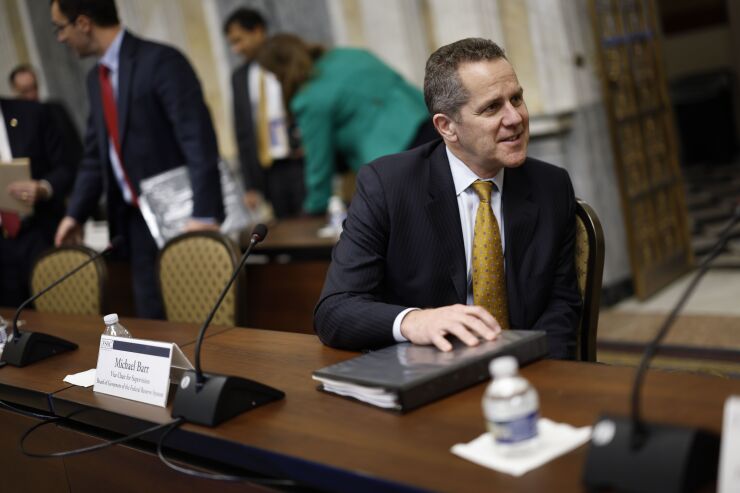
WASHINGTON — Large banks continue to be well positioned to withstand a severe recession, according to the results of the Federal Reserve's much-anticipated annual stress tests released Wednesday, but regional banks had some of the lowest minimum capital levels under the Fed's severely adverse scenario.
Federal Reserve Vice Chair for Supervision Michael Barr said in a statement that the results demonstrate that the banking sector is healthy and well capitalized, but he emphasized that the stress test is not a perfect indicator of how the industry might perform under any circumstances.
"Today's results confirm that the banking system remains strong and resilient," Barr said. "At the same time, this stress test is only one way to measure that strength. We should remain humble about how risks can arise and continue our work to ensure that banks are resilient to a range of economic scenarios, market shocks and other stresses."
While these were the Fed's first stress-test reports since three high-profile bank failures this spring, the central bank
All 23 banks assessed in this year's stress tests remained above their minimum capital requirements. Projected losses under the severely adverse scenario totaled $541 billion, the Fed said. Under that scenario, the common equity risk-based capital ratio of the banks tested fell by 2.3 percentage points to a minimum of 10.1%.
But the banks that held the lowest post-stress capital minimums were regional banks — precisely the category of bank that has been under heightened scrutiny since the recent collapses of Silicon Valley Bank, Signature Bank and First Republic Bank.
Providence, Rhode Island-based Citizens Bank, which holds $222.3 billion of assets, showed a post-stress common equity tier 1 capital ratio of 6.4%. Minneapolis-based U.S. Bank, with $584 billion of assets, had a 6.6% post-stress CET1 capital ratio, while Charlotte, Carolina-based Truist Bank, with $574 billion of assets, reported a post-stress CET1 ratio of 6.7%. The regulatory minimum CET1 ratio is 4.5%.
Larger banks, meanwhile, fared much better under the severely adverse scenario — Citigroup's post-stress CET1 ratio was 9.1%; JPMorgan Chase reported a post-stress minimum of 11.1%; Bank of America came in at 10.6%, and Wells Fargo had an 8.2% post-stress minimum.
This year's severely adverse scenario included an increase of 6.5 percentage points in the unemployment rate — bringing unemployment to 10% — as well as a widening spread on corporate bonds and a sharp devaluation of assets. It also included declines in residential real estate values of 38% and in commercial real estate values of 40%. CRE exposures remain a
Large banks would experience heavy losses under that hypothetical scenario but would be able to continue lending, according to the results. The banks included in this year's tests hold about 20% of the banking industry's office and downtown commercial real estate loans.
"The large projected decline in commercial real estate prices, combined with the substantial increase in office vacancies, contributes to projected loss rates on office properties that are roughly triple the levels reached during the 2008 financial crisis," the Fed said in a statement accompanying the stress-test results.
This year's tests also include an exploratory market shock, applied to the trading books of global systemically important banks. While those results won't be factored into capital requirements, they will be used to evaluate the resiliency of the banks and could influence how future tests are done.
"The results showed that the largest banks' trading books were resilient to the rising rate environment tested," the Fed said in the release.






